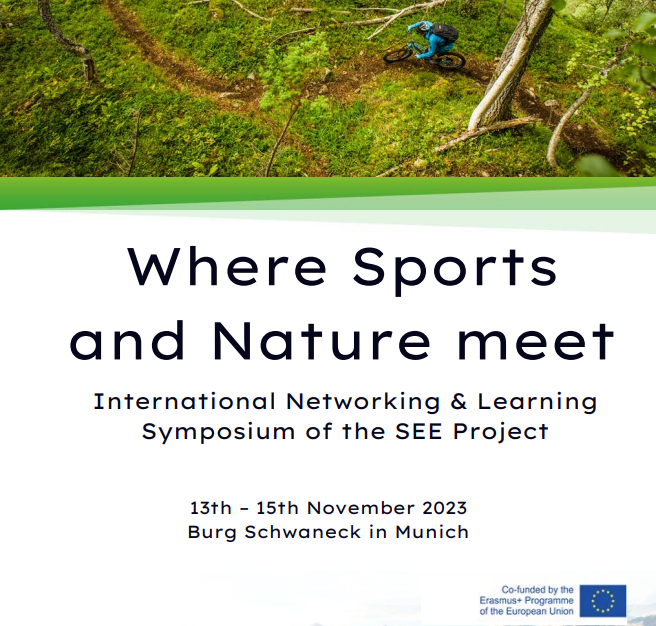A star dims in our EUROPARC firmament
It is with great sadness that EUROPARC learned of the sudden death of Wilf Fenten this week.
Wilf was a stalwart of EUROPARC having been involved in setting up and serving as Director of EUROPARC consulting which was central in managing the Charter for Sustainable Tourism and developing networking workshops in EUROPARC Atlantic Isles.
A native German, Wilf was an adopted Englishman and even more so, of Yorkshire, where he had been a board member of the Yorkshire Dales National Park as well as a local councillor. His passion for caring for the land, took a practical turn when he managed a small flock of sheep and wildflower meadows at his home in Settle. It was a source of much hilarity to hear of the sheep- adventures of “Angela Merkel“ and “Condoleezza Rice”, as the sheep were named after female world leaders.
A true European, Wilf relished the international connections he helped forge across EUROPARC. Although saddened when EUROPARC Consulting closed, his dedication to the Charter continued, as a member of the evaluation committee, who very much appreciated his long experience, knowledge and attention to detail. He had been too a Trustee of the Dales and Harrogate Tourism Partnership. Wilf’s outgoing and friendly personality served him well bringing many stakeholders together in many Protected Area European projects. These included “training the trainers” programme for the WWF Danube Carpathian and with other Protected Areas on more specialist topics such as “Cultural Heritage and Sustainable Tourism”, “Protected Areas as Testbeds for Sustainable Development” and a “Learning from Europe” project about strengthening the identity and public commitment towards English Protected Landscapes. Many will have been touched by his work and his legacy and achievements across the European Protected Areas community are evident.
Wilf loved his connections and times with EUROPARC. We understand he felt it was the most rewarding part of his life – combining work with his enthusiasm for designated landscapes all over Europe. His company was always a pleasure, you were always greeted with a huge smile and warm hug and was never without a good story from his many travels and connections. He was kind, considerate, consummately positive and emanated joy.
He was a star in our EUROPARC firmament that has sadly now dimmed.
Our deepest condolences go to Hilary and his children and grandchildren.
Complementary EUROPARC Programmes: the European Charter for Sustainable Tourism and the Junior Rangers
Junior Rangers are the future park staff, business owners, tour guides and are important stakeholders in the European Charter for Sustainable Tourism.
Involving young people in the European Charter for Sustainable Tourism
by Rolands Auzins, ECST verifier
I care. I care about what is happening around now and in the future. I am interested. I am interested in how it works, why it happens and whether it can be different. I want to get involved. I want to be a part of the present and the future and be the one who can make things better. I’m a Junior Ranger.
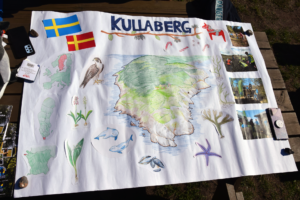
Junior Rangers showcase their Protected Area at the International Junior Ranger Camp
Sustainable Destination principles govern how tourism is developed and managed in a Protected area. The European Charter for Sustainable Tourism in Protected Areas is a management tool, to ensure a viable and healthy future for people and for nature. Let’s pause here at “people” and focus on young people – the Junior Rangers. We for nature, nature for us. It is a mutual interaction between the two EUROPARC programs.
In charter parks, engagement with young people has largely been through the EUROPARC Junior Ranger programme. This programme has been operating effectively for many years and has proven itself to be a quality activity with a clear vision for the future.
Young people are an essential part of society in a Park involved in the ECST; they are stakeholders, and they will later take our place to continue what has been started. Years from now, a former Junior Ranger will come to the Park and say – hey, I’ve been here since I was a teenager, I know you and I know what you do. I want to be part of the team and maybe do even better.
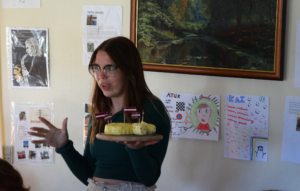
A Junior Ranger introduces others to local Latvian specialities
Young people have a different point of view, they identify their own issues, which are not only worth it, but you definitely need to delve into them, because it is another perspective. Implementation of the ECST program is not possible without the involvement of young people. Junior Ranger activities are an excellent addition to the achievement of ECST’s goals, implementing various projects, activities, and engaging in the creation of a sustainable future. The young person is a Junior Ranger all the time, whether at school, at home, or in everyday life, and when working with ECST tasks, Park staff should remember that there is a young person nearby who is ready and willing to be involved.
How we (those currently in charge of parks and especially ECST Protected Areas) manage Parks now, what decisions we make, affects us now, but will affect young people even more later. Our decisions today mostly have long-term effects, which will be best appreciated by those who do not yet have direct decision-making rights. If a park has become a Sustainable Destination, it is a long-term decision that will ensure the sustainable development of this place in the long-term and will ensure that Junior Rangers will want to return here after studying at universities. Time passes quickly, young people grow up, and they have their own requirements for life, space and place (e.g. as expressed in the EUROPARC Youth Manifesto). With the European Charter for Sustainable Tourism, a solid foundation is laid for the future together with those who now proudly call themselves the Junior Rangers.
Junior Rangers contributing to the European Charter for Sustainable Tourism in the Cairngorms National Park
by Will George, Ranger at the Cairngorms National Park and Junior Ranger Mentor
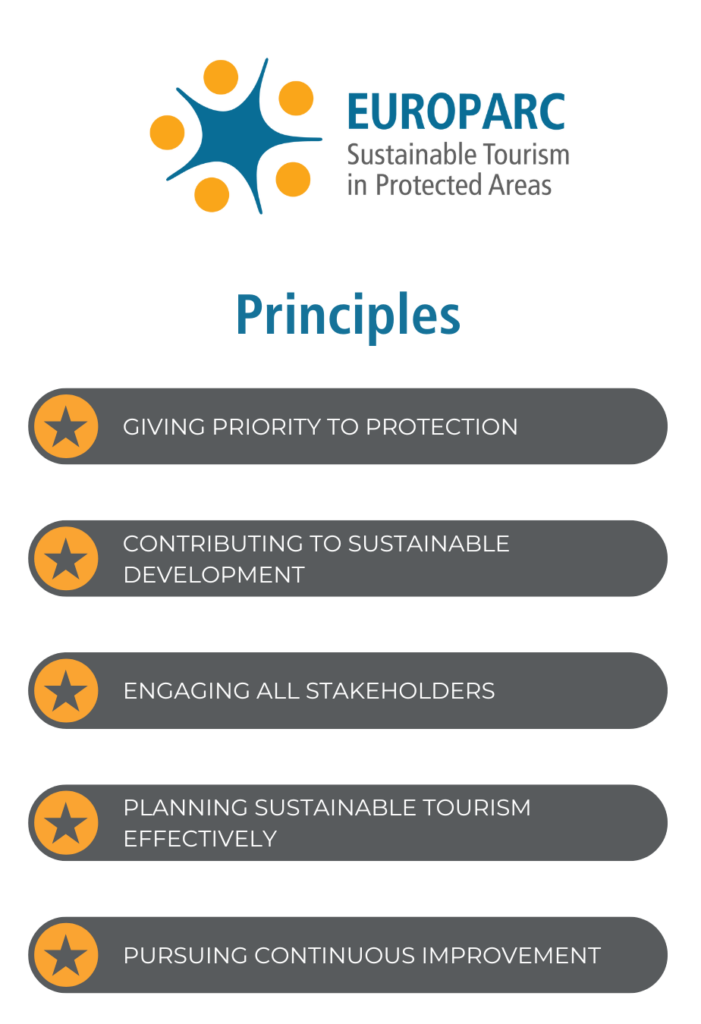 Whether repairing mountain paths, re-locating rare twin-flower or engaging with visitors about responsible access, the Cairngorms National Park Junior Rangers help to ensure a viable and healthy future for people and nature, and directly contributing to the Principles of the European Charter for Sustainable Development.
Whether repairing mountain paths, re-locating rare twin-flower or engaging with visitors about responsible access, the Cairngorms National Park Junior Rangers help to ensure a viable and healthy future for people and nature, and directly contributing to the Principles of the European Charter for Sustainable Development.
Earlier this year, four of them hiked up into the mountain plateau at the heart of the Cairngorms to deliver montane willow species to revitalise the remnant populations and increase the extremely rare montane scrub habitat. They were the youngest volunteers amongst a group organised by the Cairngorms Connect Partnership. So not only did they help to protect and improve the environment for the future, they also added passionate youth voices to a conversation involving a variety of stakeholders.
Katherine, aged 16, described what being part of the Willow Walk meant for her. “It makes us, as in the youth, feel like we’re doing something and we’re not just sitting round doing nothing. There is that sense of belonging. Being able to conserve and guarantee a future of this place for future generations makes me very happy. Doing small things to help, like bringing in the trees today, will help towards the bigger picture.”
Is your Protected Area a part of the European Charter for Sustainable Tourism?
Perhaps consider starting a Junior Ranger Programme to complement it.
Find out more on our website or send us an email!
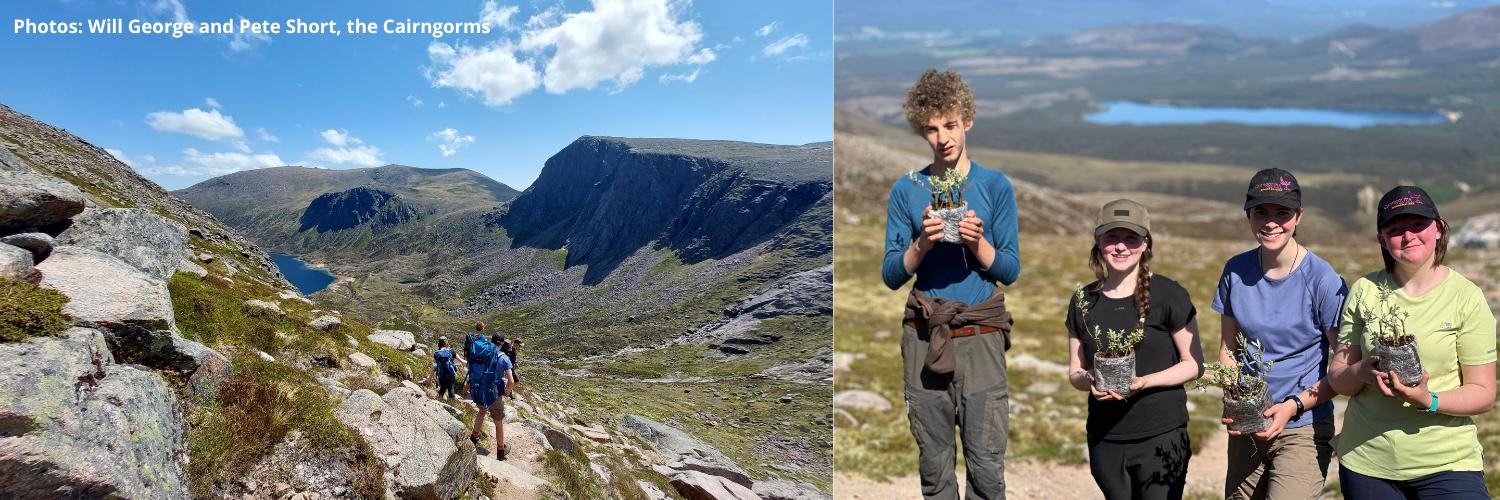
Mitigation and management across wind energy and other sectors – Sustainable development in protected areas
Caitlin Cunningham At the PWN purification area at the North Holland Dune Reserve.
Every year, the Alfred Toepfer Natural Heritage Scholarship supports the work of young conservationists in Protected Areas across Europe. Caitlin Cunningham is one of the three Alfred Toepfer Scholarship winners of 2022. In this article, she details the findings of her study visits, where she looked at mitigation and management across wind energy and other sectors.
Article written by Caitlin Cunningham, she works across marine renewable energy at NatureScot – the lead public body responsible for advising Scottish Ministers on all matters relating to the natural heritage.
Mitigation and management across wind energy and other sectors
Sustainable development in protected areas
We are currently in a twin climate and biodiversity crises. Marine renewable energy provides an opportunity to benefit climate change production, whilst simultaneously protecting and minimising impacts to biodiversity.
Across the North Sea, offshore wind is a rapidly expanding industry. Both Scotland and the Netherlands have high ambitions for the expansion of offshore wind energy. Over 45 GW of offshore wind is potentially already in the pipeline in Scottish waters, when including sites that are at the pre-application (prior to consent) stage. Meanwhile, the Netherlands have set an ambitious target of 70 GW of offshore wind by 2050. Dutch offshore wind farms are also at the forefront of biodiversity benefits, with commitments to nature-inclusive design and the development of innovative mitigation measures to protect and enhance biodiversity.
With the support of the Alfred Toepfer Natural Heritage Scholarship, I visited the Netherlands to better understand these novel mitigation techniques, potential compensation measures and examples of nature-inclusive design. I visited three nearshore wind farms – Eemshaven wind farm, Fryslân wind farm and Maasvlakte II wind farm – all located within or nearby protected areas.
Check out the video she created during her visits!
Eemshaven wind farm is adjacent to the Wadden Sea Natura 2000 site. This is a particularly important site for birds, given it is located on a major migration route. Thus, a pilot project is being trialled at Eemshaven wind farm, which involves painting one of the blades of a wind turbine black to assess the effectiveness in reducing the number of collision victims among birds. This follows on from a similar study conducted in Norway, which found a reduction of 70% in the annual collision rate, with the biggest benefits for raptor species. Monitoring is ongoing and the first year of results will be reported later in 2023, with the full project running until September 2024.
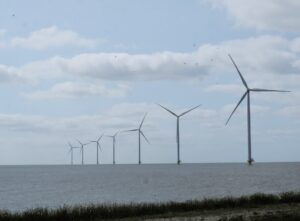
Birds flying through the Fryslân wind farm – Caitlin Cunningham
Fryslân wind farm is located within the IJsselmeer Natura 2000 site, adjacent to the Wadden Sea Natura 2000 area and is therefore an important area for many breeding and non-breeding birds, especially waterfowl. Radar is being used at this location, along with regular visual observations by ornithologists, to monitor and validate collision estimates and modelling parameters at the EIA stage. Currently, the radar is not able to identify birds to a species level. In the future, it is hoped that the radar can be trained using the visual observation data to potentially identify more distinctive species. Furthermore, an artificial island was built as a nature reserve, to further benefit biodiversity and help Fryslân wind farm be nature-positive, with the aim to leave lake IJssel in a better condition.
Maasvlakte II wind farm is a coastal development, located adjacent to the Voordelta Natura 2000 site, which is an important area for migratory birds. Nearby, a gull colony in the urbanised Port of Rotterdam area (Europoort to Maasvlakte) is home to approximately 20,000 breeding pairs of lesser black-backed gulls, with a smaller population of herring gulls. To mitigate this collision risk, a radar is being used to continuously track bird movements, with this data then used to automatically shut down turbines as needed.
Additionally, I learnt more about how these approaches are applied at offshore wind farms in the Dutch North Sea, drawing comparisons to offshore wind energy in Scotland. To achieve this, I visited two specialist locations – University of Amsterdam and the Offshore Expertise Centrum (OEC). During my study visit in May 2023, turbines at two Dutch offshore wind farms, Borssele and Egmond aan Zee, were temporarily shut down to help migrating birds pass safely. This is an international first and a positive measure for birds, especially given the global importance of the East-Atlantic flyway for migration, which crosses the North Sea.
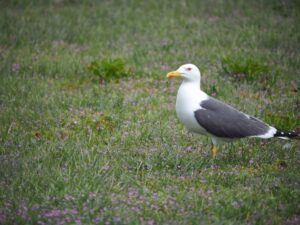
Lesser black-backed gull at Maasvlakte – Caitlin Cunningham
I was also interested in lessons learnt from other industries. I visited the Voordelta Natura 2000 site and learnt about the formal fisheries-based compensation associated with the expansion of the Port of Rotterdam in this protected area. The European Commission gave permission for the expansion on the condition that the habitat loss be compensated. However, it has come to light that the compensation has not been effective and other measures must quickly be secured.
To better understand how other industries implement sustainable development in protected areas, I visited a water treatment plant and the North Holland Dune Reserve managed by the water company, Puur Water & Natuur (PWN). As part of the water purification process, water is transported to the dunes on the coast to naturally filter the water. To improve the condition of the reserve, infiltration ponds and dune slacks have been redesigned, to help promote the young successional stages of wet dune slacks. As sea level rise increases, this poses a risk to the drinking water supply through saltwater intrusion. Thus, the drinking water companies have a vested interest to conserve and enhance the dune systems to improve resilience to future threats and preserve the ecosystem services the dunes provide.
The associated report presents the findings of my visit, including recommendations for the offshore wind sector, with a particular focus on relevance to Scotland.
Where Sports and Nature meet | International Networking & Learning Symposium of the SEE Project
The partners of the Sustainability and Environmental Education in Outdoor Sports project (SEE) invite you to attend the final Project Learning Symposium in Munich from the 13th – to the 15th of November 2023. The main program is scheduled for the 14th of November.
The SEE Project aims to enhance the protection of natural landscapes through education in and through sport with special focus on responsible outdoor behaviour and skills development for outdoor sports leaders, trainers, guides, or instructors.
During the SEE Learning Symposium, hosted at the beautiful Burg Schwaneck just outside of Munich, attendees will learn about current challenges and opportunities of outdoor sports practiced in (Protected) Natural Areas and how to address these through newly developed training methodologies in Outdoor Sports education.
The programme
The symposium is an opportunity to bring together an international audience from both the outdoor sports sector and the environmental protection sector to share ideas, transfer knowledge and work on future collaborations. The program will include ample opportunities to learn and network from one another through various facilitated networking sessions with project partners and experts, interactive activities, and demonstrations of the SEE Educational Toolkit.
The learning symposium will be a full-day programme (Tuesday) which includes practical workshop sessions where partner organisations of the project will demonstrate several toolkit activities. In addition to the toolkit demonstration, the program will include inspirational speeches from leaders in environmental activism, networking activities, dinner, and social program in the evening.
Extend your stay and join the SEE project partners for an early bird outdoor activity on Wednesday morning followed by a workshop session and a deep dive networking session which will focus on specific topics related to different environments and sport types.
Download the Programme now!Is this event for me?
If you are working in the outdoor sports sector as trainer, tutor, or any other educational role (eg. at a Sports University, sports federation, outdoor training centre, VET provider in the field of OS), or in the outdoor sports / adventure travel tourism sector, then this Learning symposium is the best opportunity to gain new insights in the latest developments of sustainability and environmental education in outdoor sports.
Are you working for a National Park or Protected Area (e.g. member of the EUROPARC Federation) or working with guiding companies, travel agencies in your capacity as land manager, outdoor recreation manager, forestry manager etc.? Then this learning symposium will have valuable insights for you as well and provide great opportunities to have a dialogue to strengthen the relationship between nature and the outdoor sport sector.
Ticket fee
Registration for the event includes lunch, coffee breaks and dinner on Tuesday (other meals /drinks are at own expense). The ticket fee of €20,- will be used to offset the total carbon footprint of the event (e.g. international travelling and overnight stays of the attendees). Of course, participants are encouraged to make use of public transportation as much as possible.
Register here!Call for contributions
The closing date for the submission is 30th September 2023
I want to contribute!If your organisation has been involved in some aspect of innovative sustainable or environmental education practices, then we would love to hear about it and share your ideas with others.
